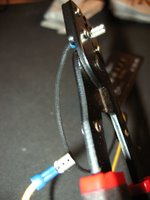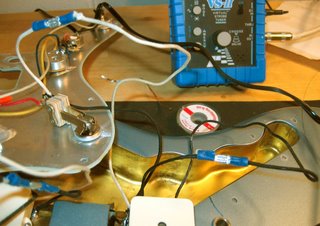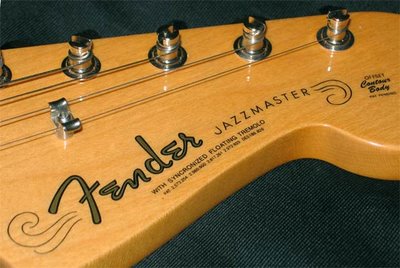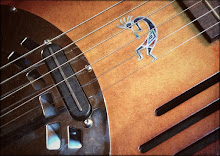Thursday, July 13, 2006
How I'm doing it.
My methodology is pretty simple. I'm trying to keep everything as "normal" as possible, varying only the pickups.  Jazzmaster (strung with Pyramid flatwound .11s) -> 1968 Fender Princeton Reverb -> Shure SM-57 -> M-Audio OmniStudio/Delta 44 -> Sonar. No compression, no eq, and so on. There will be a clip of the bridge, neck, and combined tones of each configuration. I'll do the stock AVRI pickups first, to give a baseline. That way, you can sort of orient yourself to my playing & the basic sound of the amp & set-up. Then, the Lollars, then the Novaks. For the Novaks, I will always use the Novak neck pickup, and only vary the bridge pickups. Each new pickup will have a photo from several angles, as well as my comments on it.
Jazzmaster (strung with Pyramid flatwound .11s) -> 1968 Fender Princeton Reverb -> Shure SM-57 -> M-Audio OmniStudio/Delta 44 -> Sonar. No compression, no eq, and so on. There will be a clip of the bridge, neck, and combined tones of each configuration. I'll do the stock AVRI pickups first, to give a baseline. That way, you can sort of orient yourself to my playing & the basic sound of the amp & set-up. Then, the Lollars, then the Novaks. For the Novaks, I will always use the Novak neck pickup, and only vary the bridge pickups. Each new pickup will have a photo from several angles, as well as my comments on it.
The other major hurdle was the actual process I would use. Another forum member over at the Gear Page, mezcalhead, suggested I use some crimp-on quick disconnects, so I didn't have to constantly be soldering. So, down to Radio Shack I went, and picked up some of these, and some of these.
 That part wasn't too hard. I put female ends on all the pickups, and the opened up the guitar. I desoldered the pickup wires from the guitar, and replaced them with short "jumpers," each of which had male ends. Here, I had my first problem -- for some reason, the male ends didn't much care for my crimper, and I kept screwing them up. I eventually determined that the plastic collars didn't get along so well with the crimper. Live & learn.
That part wasn't too hard. I put female ends on all the pickups, and the opened up the guitar. I desoldered the pickup wires from the guitar, and replaced them with short "jumpers," each of which had male ends. Here, I had my first problem -- for some reason, the male ends didn't much care for my crimper, and I kept screwing them up. I eventually determined that the plastic collars didn't get along so well with the crimper. Live & learn.

While switching out pickups, I did learn one thing: Quick disconnects aren't.
The female parts grab rather too tightly to the male parts, and simply don't want to let them go. I wound up loosening them all slightly. (You -- there in the peanut gallery. We're talking electronics, here, not Freudian psychology.) From then on, things went pretty well. As I write this, I've already done about half the pickups; all that's left are the various Novak bridge pickups (except for the P-90. I tried that one first.) The system does seem to work pretty well, for anyone who might be mad enough to try to do a similar process. However, I'm not sure that the quick-disconnects are really much easier to manage, all things considered, than soldering on jumpers, and just soldering & desoldering the pickups to the jumpers.

Before we get to the reviews, one final note about clips: Some people like them, some people hate them. I think they have their uses, but those uses are limited. Every guitar is different, every amp is different, and, most importantly, every player is different. Then, you have to factor in the abilities of the person doing the recording, and how good their system is -- all of which gets smashed up by compression down to MP3. Still, everything else being equal -- and I've striven to make it all as equal as possible -- you can get an idea of how various pickups differ from each other, as all the common variables tend to cancel out. I played more or less the same thing for every clip -- some single note leads, as well as chords -- and recorded it without any spring reverb. For each combo, I also did a longer jam, with lovely drippy Fender spring reverb, that highlights each of the pickup positions, so you can get a slightly better feel for the pickups in context. Jim Thomas I'm not, but it was fun to do.
Next up: Fender's stock American Vintage Reissue Jazzmaster pickups.
 Jazzmaster (strung with Pyramid flatwound .11s) -> 1968 Fender Princeton Reverb -> Shure SM-57 -> M-Audio OmniStudio/Delta 44 -> Sonar. No compression, no eq, and so on. There will be a clip of the bridge, neck, and combined tones of each configuration. I'll do the stock AVRI pickups first, to give a baseline. That way, you can sort of orient yourself to my playing & the basic sound of the amp & set-up. Then, the Lollars, then the Novaks. For the Novaks, I will always use the Novak neck pickup, and only vary the bridge pickups. Each new pickup will have a photo from several angles, as well as my comments on it.
Jazzmaster (strung with Pyramid flatwound .11s) -> 1968 Fender Princeton Reverb -> Shure SM-57 -> M-Audio OmniStudio/Delta 44 -> Sonar. No compression, no eq, and so on. There will be a clip of the bridge, neck, and combined tones of each configuration. I'll do the stock AVRI pickups first, to give a baseline. That way, you can sort of orient yourself to my playing & the basic sound of the amp & set-up. Then, the Lollars, then the Novaks. For the Novaks, I will always use the Novak neck pickup, and only vary the bridge pickups. Each new pickup will have a photo from several angles, as well as my comments on it.The other major hurdle was the actual process I would use. Another forum member over at the Gear Page, mezcalhead, suggested I use some crimp-on quick disconnects, so I didn't have to constantly be soldering. So, down to Radio Shack I went, and picked up some of these, and some of these.
 That part wasn't too hard. I put female ends on all the pickups, and the opened up the guitar. I desoldered the pickup wires from the guitar, and replaced them with short "jumpers," each of which had male ends. Here, I had my first problem -- for some reason, the male ends didn't much care for my crimper, and I kept screwing them up. I eventually determined that the plastic collars didn't get along so well with the crimper. Live & learn.
That part wasn't too hard. I put female ends on all the pickups, and the opened up the guitar. I desoldered the pickup wires from the guitar, and replaced them with short "jumpers," each of which had male ends. Here, I had my first problem -- for some reason, the male ends didn't much care for my crimper, and I kept screwing them up. I eventually determined that the plastic collars didn't get along so well with the crimper. Live & learn.
While switching out pickups, I did learn one thing: Quick disconnects aren't.
The female parts grab rather too tightly to the male parts, and simply don't want to let them go. I wound up loosening them all slightly. (You -- there in the peanut gallery. We're talking electronics, here, not Freudian psychology.) From then on, things went pretty well. As I write this, I've already done about half the pickups; all that's left are the various Novak bridge pickups (except for the P-90. I tried that one first.) The system does seem to work pretty well, for anyone who might be mad enough to try to do a similar process. However, I'm not sure that the quick-disconnects are really much easier to manage, all things considered, than soldering on jumpers, and just soldering & desoldering the pickups to the jumpers.

Before we get to the reviews, one final note about clips: Some people like them, some people hate them. I think they have their uses, but those uses are limited. Every guitar is different, every amp is different, and, most importantly, every player is different. Then, you have to factor in the abilities of the person doing the recording, and how good their system is -- all of which gets smashed up by compression down to MP3. Still, everything else being equal -- and I've striven to make it all as equal as possible -- you can get an idea of how various pickups differ from each other, as all the common variables tend to cancel out. I played more or less the same thing for every clip -- some single note leads, as well as chords -- and recorded it without any spring reverb. For each combo, I also did a longer jam, with lovely drippy Fender spring reverb, that highlights each of the pickup positions, so you can get a slightly better feel for the pickups in context. Jim Thomas I'm not, but it was fun to do.
Next up: Fender's stock American Vintage Reissue Jazzmaster pickups.
The History

In the next few weeks, I'll be showing pictures, clips, and descriptions of a dozen Jazzmaster pickups. I'm not trying to find the best pickup. All of these pickups are worthy of consideration. However, different players have different needs. Hopefully, the information in this blog will give you some help in deciding how to spend your cash. The obvious question is, "Why would someone do this, other than the obvious response of, 'Utter lunacy?'"
Same as most guitarists, I'm always in search of the elusive, ever-changing tone. Not just a sound, but sound that makes you sit up & take notice. So, I've got an ever changing collection of guitars, amps, pedals, and so on. But just getting a new piece of kit doesn't end the quest for tone. That's when I take an off-the-rack instrument and make it my own.
As a big surf fan, I've loved Jazzmasters for a long time. This past May, I got a brand new, ice blue American Vintage '62 Jazzmaster Reissue. Before I even received the guitar, I knew one change I would make already: the mint green pickguard had to go, to be replaced by the much-more-stylish tortoiseshell. A good start, but I needed to do more.
Within a month, I had decided I needed new pickups. Everything else I was very happy with. And, honestly, I wasn't unhappy with the stock pickups -- I just wanted more. More nuance, more harmonics, more output, and, not to be forgotten, more solder fumes!
 In the past, I'd owned a Japanese Jazzmaster, which the previous owner had pretty heavily modded -- all new pots, switches and caps, and a set of Seymour Duncan pickups. I didn't really like the pickups (and the guitar was good, but not great, for me) so I wasn't too interested in another set of Duncans.
In the past, I'd owned a Japanese Jazzmaster, which the previous owner had pretty heavily modded -- all new pots, switches and caps, and a set of Seymour Duncan pickups. I didn't really like the pickups (and the guitar was good, but not great, for me) so I wasn't too interested in another set of Duncans.Over at the Jazzmaster & Jaguar forum on the Fender Discussion Page, I had already learned a great deal about Jazzmasters. The two pickup makers, other than Seymour, who got good reviews were Jason Lollar & Curtis Novak. I'd already used several other Lollars in various guitars, and knew that they were incredible pickups. But Novak was unknown to me, and he had some really interesting variations on the basic JM pickup. So I emailed Curtis.
We talked a bit, back & forth. He was, like so many folks creating custom musical equipment, obviously passionate about his work, and willing to bend over backwards to help. I ordered a vintage-style neck pickup and a bridge pickup based on a P-90.
The pickups arrived quickly, and I popped them in. I immediately really liked the neck pickup, but didn't jibe with the bridge. So, I emailed Curtis, and he offered to take a few thousand winds off, which would give the pickup a clearer, less overpowering (to my ears) tone. We talked some more, and Curtis offered to send me several different bridge pickups, and let me choose which one I wanted to keep, and I'd send the rest back. How could I say no?
In the meantime, curiosity had gotten the best of me, and I grabbed a set of Lollar JM pickups. I liked those a lot, too.
Well, Curtis sends me email, listing a half dozen or so pickups, and, before I get a chance to tell him which I want to choose from, he sends them all along.
So here I am, with a dozen JM pickups -- 7 bridge pickups from Curtis, a Novak neck, a set of Lollars, and the stock AVRI pickups. I figure, this is a great opportunity! I'll do a Jazzmaster pickup shootout. Not liking the idea of a "shootout," I decide -- it's a jam.
So, here I am. I've got the pickups, I've got the guitar, and I've got a soldering iron -- and I'm not afraid to use it!
